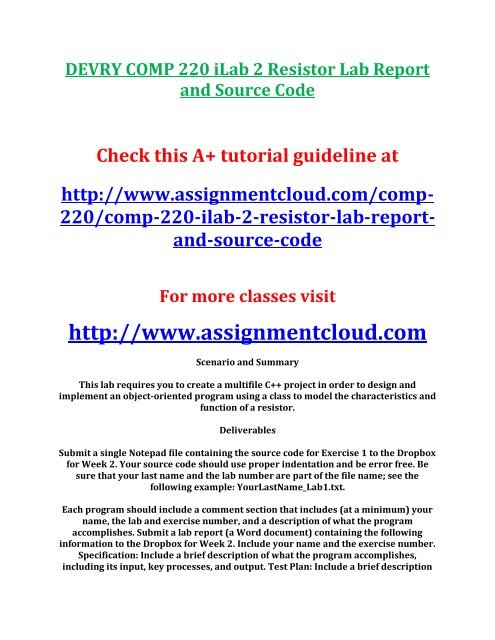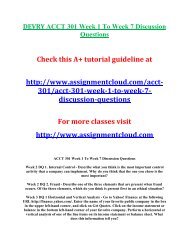DEVRY COMP 220 iLab 2 Resistor Lab Report and Source Code
comp 220,comp 220 entire course,comp 220 devry,devry comp 220,comp 220 lab 2 source code,comp i lab report,devry comp 220 ilab 2 report and source code,devry comp 220 ilab 2 report source code,comp 220 ilab 2 lab report and source code
comp 220,comp 220 entire course,comp 220 devry,devry comp 220,comp 220 lab 2 source code,comp i lab report,devry comp 220 ilab 2 report and source code,devry comp 220 ilab 2 report source code,comp 220 ilab 2 lab report and source code
You also want an ePaper? Increase the reach of your titles
YUMPU automatically turns print PDFs into web optimized ePapers that Google loves.
<strong>DEVRY</strong> <strong>COMP</strong> <strong>220</strong> <strong>i<strong>Lab</strong></strong> 2 <strong>Resistor</strong> <strong>Lab</strong> <strong>Report</strong><br />
<strong>and</strong> <strong>Source</strong> <strong>Code</strong><br />
Check this A+ tutorial guideline at<br />
http://www.assignmentcloud.com/comp-<br />
<strong>220</strong>/comp-<strong>220</strong>-ilab-2-resistor-lab-report<strong>and</strong>-source-code<br />
For more classes visit<br />
http://www.assignmentcloud.com<br />
Scenario <strong>and</strong> Summary<br />
This lab requires you to create a multifile C++ project in order to design <strong>and</strong><br />
implement an object-oriented program using a class to model the characteristics <strong>and</strong><br />
function of a resistor.<br />
Deliverables<br />
Submit a single Notepad file containing the source code for Exercise 1 to the Dropbox<br />
for Week 2. Your source code should use proper indentation <strong>and</strong> be error free. Be<br />
sure that your last name <strong>and</strong> the lab number are part of the file name; see the<br />
following example: YourLastName_<strong>Lab</strong>1.txt.<br />
Each program should include a comment section that includes (at a minimum) your<br />
name, the lab <strong>and</strong> exercise number, <strong>and</strong> a description of what the program<br />
accomplishes. Submit a lab report (a Word document) containing the following<br />
information to the Dropbox for Week 2. Include your name <strong>and</strong> the exercise number.<br />
Specification: Include a brief description of what the program accomplishes,<br />
including its input, key processes, <strong>and</strong> output. Test Plan: Include a brief description
of the method you used to confirm that your program worked properly. If necessary,<br />
include a clearly labeled table with test cases, predicted results, <strong>and</strong> actual results.<br />
Summary <strong>and</strong> Conclusions: Include a summary of what the lab demonstrated <strong>and</strong> any<br />
conclusions drawn from the testing of the lab program. Answers to <strong>Lab</strong> Questions:<br />
Answer any <strong>and</strong> all lab questions included in the lab steps.<br />
Summary: Write a statement summarizing your predicted <strong>and</strong> actual output. Identify<br />
<strong>and</strong> explain any differences.<br />
Conclusions: Write at least one nontrivial paragraph that explains, in detail, either a<br />
significant problem you had <strong>and</strong> how you solved it or, if you had no significant<br />
problems, something you learned by doing the exercise.<br />
Each lab exercise should have a separate section in the lab-report document.<br />
Your lab grade will be based upon<br />
the formatting of your source code; the use of meaningful identifiers; the extent of<br />
internal documentation; the degree to which an exercises’ specifications are met;<br />
<strong>and</strong> the completeness of your lab report.<br />
i L A B S T E P S<br />
STEP 1: Create a Multifile Project<br />
Objective: Create a C++ console application that will model the characteristics of a<br />
resistor.<br />
Create a multifile project. Create <strong>and</strong> add to the project an h file containing the<br />
resistor-class definition. Create <strong>and</strong> add to the project a cpp file containing the<br />
implementation of the class-member functions. Create <strong>and</strong> add to the project a ccp<br />
file containing the main() function, which will instantiate a resistor object <strong>and</strong> test<br />
its member functions.<br />
STEP 2: Required Class Members<br />
The resistor class will, at minimum, have members that do the following.<br />
store the nominal resistance value of a resistor store the tolerance of a resistor<br />
initialize any <strong>and</strong> all nominal-resistance values to correct, EIA, nonzero values that<br />
are greater than 0 <strong>and</strong> less than 1,000,000 ohms initialize any <strong>and</strong> all resistancetolerance<br />
values to correct, E12, E24, E48, or E96 resistance-tolerance values allow<br />
the nominal-resistance <strong>and</strong> tolerance values of a resistor object to be changed by the<br />
user All member functions should have a test message stating the name of the<br />
function. All the test messages should be displayed or not displayed, depending on<br />
the value of a Boolean variable declared in main(). If the Boolean , display the<br />
message. If the Boolean , do not display the message.
STEP 3: Program Operations<br />
Function main() should instatiate two objects of class resistor. Function main()<br />
should display the current values of all resistor objects. Function main() should also<br />
calculate <strong>and</strong> display the minimum <strong>and</strong> maximum in-tolerance resistance values of<br />
each resistor object from the resistor data members. Function main() should allow<br />
the user to change the values of the nominal resistance <strong>and</strong> the resistor tolerance of<br />
both resistor objects, <strong>and</strong> it should also correctly h<strong>and</strong>le out of numeric-range input.<br />
Main() is also responsible for making sure that the user can successfully enter only<br />
correct, EIA resistance <strong>and</strong> tolerance values. The user should be given the following<br />
data-entry choices: accept current EIA values for resistance <strong>and</strong> tolerance; The<br />
function main() should display the new, modified values of the resistor object,<br />
including the new min <strong>and</strong> max in-tolerance resistance values. The function main()<br />
should be executed twice: once with the test messages displayed <strong>and</strong> once without.<br />
STEP 4: <strong>Lab</strong> Questions<br />
You are not required to copy the question text into your document, but all answers<br />
should be listed with the question number they answer.<br />
List the complete reference-source information for where you found the EIA<br />
st<strong>and</strong>ard resistor value <strong>and</strong> tolerance information. How was this reference<br />
discovered <strong>and</strong> where? The constructor requires the initialization values for the<br />
nominal resistance <strong>and</strong> the tolerance when an object is instantiated to be a correct E-<br />
series resistance <strong>and</strong> tolerance combination. Describe how this was accomplished in<br />
your program design <strong>and</strong> implementation. In the lab, you were required to provide<br />
mutator functions to change the nominal-resistance <strong>and</strong> tolerance values of a<br />
resistor object. Describe how this was accomplished so that the user could not enter<br />
an invalid nominal-resistance <strong>and</strong> E-series tolerance combination. Describe how this<br />
process was different <strong>and</strong>/or similar to how you implemented this validation in the<br />
class constructor.

















